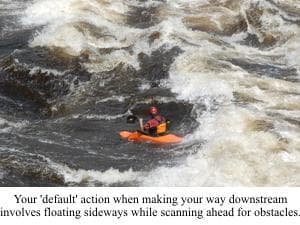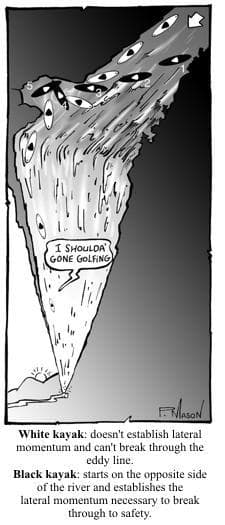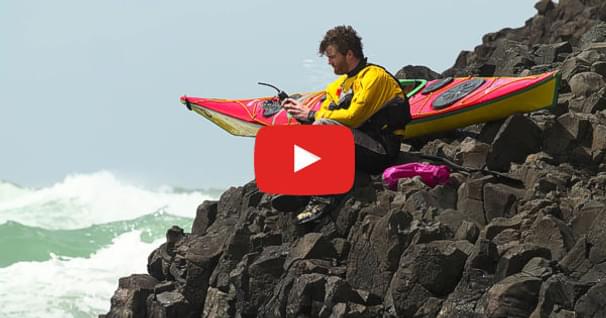Lateral Momentum
Lateral momentum refers to the speed we generate perpendicular to the main current. For most river running moves, lateral momentum is more important to establish than downstream momentum. For example, consider ferrying across the river, pulling into an eddy, avoiding a hole, or breaking through a big reactionary--they all require some lateral momentum.

In general, to get to one side of the river, you want to start on the other side or at least far enough out to establish enough lateral momentum to get yourself where you are aiming. This can often mean crossing directly above the very feature that you are trying to avoid, which can certainly be intimidating. For this reason, the challenges associated with learning to use lateral momentum are largely mental ones. If you need to break into an eddy or punch through a reactionary on one side of the river, it's only natural to want to start on that side of the river. This can be problematic, since the net effect of waves and holes on the side of a river is to push things out towards the centre. However, without adequate lateral momentum, you might not make the move you are going for.
Let's now take a look at how the importance of lateral momentum it will impact your approach to running rapids as you improve as a paddler.
When learning to kayak, you're often taught that if in doubt, keep paddling. The reason is simple. Every paddle stroke that you take effectively acts as a brace. When learning, you don't have enough experience to anticipate how the river will push you around, so you're best off paddling and bracing your way through a rapid. As you gain experience and confidence, you gain the capacity to foresee the effects that waves and currents will have on your boat. As this happens, you will change your approach to running rapids. Continuous paddling will no longer be your "default" action. Your default action will now involve floating downstream sideways with your eyes scanning ahead for obstacles.

There are a number of reasons for this. Firstly, a river's current is usually carrying you downstream at a horse's pace without any forward paddling. Unless you're in a hurry or need to build downstream speed to clear an obstacle, then there's no real use in speeding up your descent. Secondly, if you do see an obstacle or a danger ahead, paddling forward is just taking you there more quickly! It also means that you have to turn your kayak almost completely around to establish an effective ferry angle. When floating downstream sideways, just a small sweep stroke will move you onto a powerful ferry angle in either direction. You are also moving the same speed as the main current, so that catching any waves to help you ferry out of the way will be much easier. The key to floating sideways through waves is staying loose at the hips, so that your kayak can follow the contours of the river while your body stays balanced over top.
Reaching a level of comfort on the water where you can float downstream sideways is a significant milestone for any paddler. It indicates that you have developed the balance, confidence and awareness to go with the flow, and to effectively read whitewater from within their kayak. Not only will it let you challenge more difficult and continuous whitewater, but it also marks a new level of paddling independence. Once you reach this point, your next major challenge involves learning to use river features and the power of the river to help you establish lateral momentum. But that's another story...
Ken is a World Champion Kayaker and the author and producer of an award winning series of instructional kayaking books and videos. For more info, check out www.helipress.com
Related Articles
How many of you have ever heard that paddle craft (vessels under oars according to the Navigation Rules)…
Even though they are flipping over, missing their gates and failing their maneuvers, they still look…
It's important to know when to call for help. If a situation isn't getting better, and you don't think…
The following is a modified excerpt from Ken Whiting's book, 'The Ultimate Guide to Whitewater…



